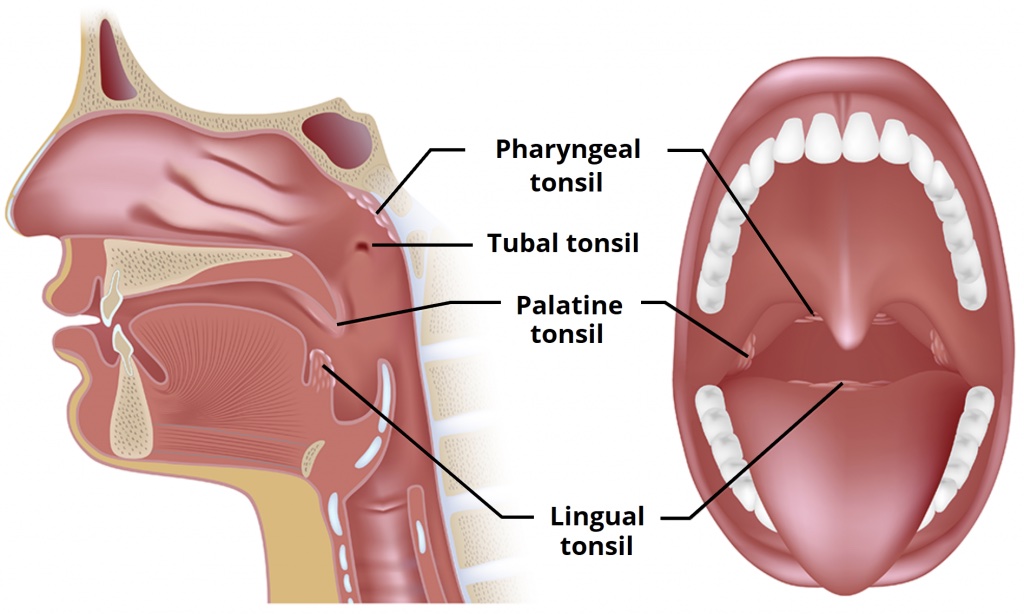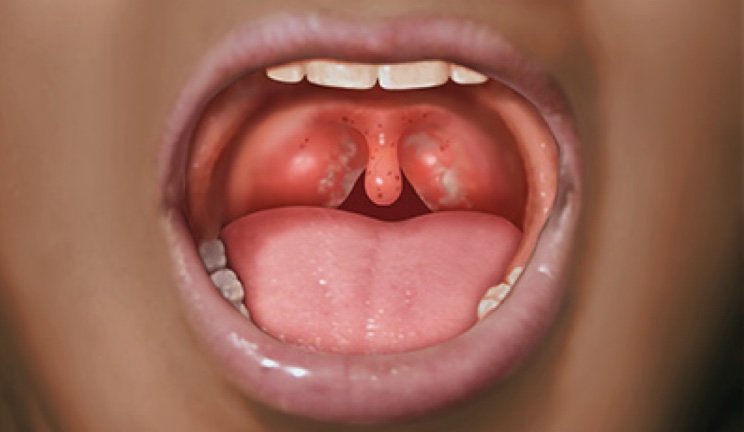Tonsillitis means inflammation of the palatine tonsils following infection. The palatine (or faucial) tonsils, commonly referred to as tonsils, are lymphoid tissue aggregates or bundles of lymphatic tissues situated near the entrance of the digestive and respiratory tracts and play a key role in our immune system. The Tonsils are part of the mucosa-associated lymphoid tissue abbreviated (MALT) which is also found in the bowel, in Peyer’s patches.
They act as a front-line defense forming the initial immunological response to inhaled or ingested pathogens. The lymphatic tissues located in the oropharynx are composed of a circumferential tonsillar ring, known as the Waldeyer’s ring, which consists of viz:
- The palatine tonsils (faucial tonsils).
- Adenoid (nasopharyngeal tonsil).
- Lingual tonsil.
- Tubal tonsils.
When patients and doctors discuss tonsils, they are often referring to the palatine tonsils located at the back of the throat between the two palatine arches (pillars).

What is Tonsillitis?
Due to their anatomic location near the entrances of the respiratory and gastrointestinal tracts and their functions, the palatine tonsils get exposed to a myriad of exogenous foreign materials and frequently the tonsils themselves become the objects of infection.
Tonsillitis therefore refers to inflammation of the palatine tonsils following infection. It is usually caused by viral and bacterial infections, with bacteria accounting for about 1 out of every 3 cases.
Tonsil Conditions
-
Acute Tonsillitis
This results from bacteria or viral infection of the tonsils, causing swelling and a sore throat. Acute bacterial tonsillitis may present with the sudden onset of throat pain, enlarged erythematous or with a gray/white coating (exudate), malodorous breath, and tender cervical lymph nodes.
It may be challenging to differentiate bacterial from viral etiologies of tonsillitis. While the treatment of viral disease is mainly supportive care, the treatment of routine, mild tonsillitis is pain control and antibiotics (amoxicillin or macrolides). For recurrent tonsillitis, removal of the tonsils (tonsillectomy ) is the recommended.
-
Chronic Tonsillitis
Chronic tonsillitis usually results from repeated attacks of acute tonsillitis in which the tonsils become progressively damaged and provide a reservoir for infective organisms.
-
Peritonsilar Abscess ( also called Quincy)
An infection creates a pocket of pus next to the tonsil. An abscess develops when infection penetrates the capsule and enters the peritonsillar space pushing it toward the opposite side.
Presenting signs and symptoms of a peritonsillar abscess include dysphagia, odynophagia, trismus, and a classic muffled voice. Peritonsillar abscesses must be drained urgently.
-
Acute Mononucleosis
Usually caused by the Epstein-Barr virus, “mono” causes severe swelling in the tonsils, fever, sore throat, rash and fatigue
-
Strep Throat
Streptococcus, a bacterium, infects the tonsils and throat. Fever and often accompany the sore throat.
-
Hypertrophic Tonsils
Large tonsils reduce the size of the airway, thus causing sleep apnea and snoring.
-
Tonsilloliths
Also called tonsil stones tonsil stones are formed when trapped debris hardens, or calcifies. They are most often asymptomatic but may lead to issues including halitosis, otalgia, and foreign body sensation.
Management is conservative, and patients are encouraged to extract tonsilloliths by using cotton swabs. However, large troublesome tonsilloliths require surgical extraction. Mouth rinses and gargling may be beneficial in combating halitosis caused by tonsilloliths.
-
Tonsilar cancers
Tonsils may also be a site of cancer sometimes caused by the human papilloma
Symptoms of Tonsillitis
- Sore throat.
- Problems swallowing.
- High temperature of 38C or above.
- Coughing.
- Headache.
- Feeling sick.
- Earache.
- Feeling tired.
- Sometimes, the symptoms may be sever and include
-
- Swollen, painful gland in the neck
- White pus filled spot on the tonsils
- Bad breath
Causes of Tonsillitis
Viruses are the most common cause of tonsillitis. The viruses that cause the common cold are often the source of tonsillitis, but other viruses can also cause it, including:
- Rhinovirus
- Epstein-Bar Virus
- Hepatitis A Virus
- HIV
Since the Epstein-Barr virus can cause both mononucleosis and tonsillitis, sometimes people with mono will develop tonsillitis as a secondary infection.
Bacterial tonsillitis is most common in children between the ages of 5 to 15 years. Around 5 to 30 % of tonsillitis cases in this age group result from bacteria. Most often, it’s strep bacteria, which causes strep throat. But other bacteria can also cause tonsillitis.
Investigations for Tonsillitis
- Complete blood count (CBC).
- Rapid antigens test for Group A beta-hemolytic streptococcus (GABHS).
- Throat Swab test for microscopy culture and sensitivity (M/C/S).
- Blood test for granular fever if symptoms are sever and will not go away.
-
Monospot Test
Blood tests that can detect certain antibodies that can help confirm that a person’s symptoms are due to mononucleosis.
-
Epstein –Bar Virus antibodies (EBV)
If a Monospot test is negative, antibodies in the blood against EB might help diagnose mononucleosis.

Diagnosis of Tonsillitis
-
Clinical evaluation
Tonsillitis itself is easily recognized clinically. However, its cause is not. The tonsils are checked by gently placing a tongue spatula to depress the tongue and ask the patient to say “aaahhh” while a bright light is shone on the back of the throat. An inflamed tonsils will look bright red and swollen.
-
Test results
Results from complete blood count will help to show if the infection is viral or bacterial and this may affect the treatment options. Also a Rapid antigens test for Group A beta-hemolytic streptococcus (GABHS) can be quickly be done and result got immediately and if negative, throat swab microscopy culture and sensitivity is requested. This helps to identify the cause of the throat infection.
Tonsillitis Complications
Inflammation or swelling of the tonsils from frequent or ongoing (chronic) tonsillitis can cause complications such as:
- Disrupted breathing during sleep (obstructive sleep apnea)
- Infection that spreads deep into surrounding tissue (tonsillar cellulitis)
- Infection that results in a collection of pus behind a tonsil (peritonsillar abscess)
If tonsillitis caused by group A streptococcus or another strain of streptococcal bacteria isn’t treated or if antibiotic treatment is incomplete, increased risk of rare disorders may result especially in children viz:
- Rheumatic fever
A serious inflammatory condition that can affect the heart, joints, nervous system and skin
- Complications of scarlet fever
A streptococcal infection characterized by a prominent rash.
- Inflammation of the kidney (post streptococcal glomerulonephritis)
- Post streptococcal reactive arthritis
A condition that causes inflammation of the joints
Treatment for Tonsillitis
-
Symptomatic treatment
Supportive treatments for tonsillitis include:
-
- Analgesia
Analgesics may be systemic or topical. Nonsteroidal anti-inflammatory drugs (NSAIDs) are usually effective systemic analgesics.
Some clinicians also give a single dose of a corticosteroid (e.g., dexamethasone 10 mg IM), to help shorten symptom duration.
-
- Hydration
- Rest
-
Antibiotics for GABHS
Tonsillitis due to bacterial infection is treated with antibiotics
-
Tonsillectomy
In cases of tonsils that are too large or repeatedly infected, surgery to remove them may be necessary.
Current guidelines recommend surgical intervention for recurrent tonsillitis when a patient is found to have suffered up to seven infections in one year, five infections per year for two years, or three infections per year for three consecutive years.
Conclusion
Tonsillitis is most common in children, because they come into close contact with others every day at school and play. This potentially exposes them to a variety of viruses and bacteria. However, adults can get tonsillitis too. Frequent exposure to other people (taking public transportation or doing other activities alongside large groups of people ) increases the risk of encountering a person with tonsillitis.
Symptoms of tonsillitis due to a bacterial infection usually improve a few days after stating antibiotics. The infection is however considered transmissible until antibiotics have been taken for a 24-hour period. Tonsillectomy (Removal of the tonsils) does not produce any clinically significant immunologic deficiency. Please see your ENT if you suspect tonsillitis.

